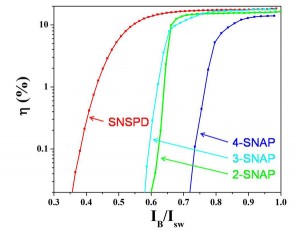Superconducting Nanowire Single-photon-detectors Based on 30-nm-wide Nanowires
In order to improve the sensitivity of superconducting nanowire single-photon-detectors (SNSPDs [1] ) at telecom wavelengths and extend it to the middle infrared range, we fabricated SNSPDs based on 30-nm-wide nanowires (see Figure 1).
To make the photodetection pulse detectable with standard room-temperature electronics, N nanowires were arranged in a parallel architecture such that when one section fired, the current flowing through the whole device was redirected to the read-out circuitry (Superconducting Nanowire Avalanche Photodetector: SNAP) [2]. The signal-to-noise ratio was then N times higher than with a series design.
The single-photon detection efficiency (DE) of 30-nm-wide nanowire SNSPDs and of 2-, 3- and 4-section SNAPs was measured for 1550-nm wavelength at a temperature of 4.7 K. The DE exhibited a reduced dependence on the bias current (IB) compared with 100-nm-wide SNSPDs. This reduced dependence allowed operating narrow SNSPDs at an IB (~ 50 % of the critical current IC) far lower than with wide SNSPDs (typically ~ 95 % of IC) for the same DE. This reduction in the operating bias current would in principle improve the detector sensitivity, as the dark count rate (DK) of SNSPDs decreases exponentially with IB. However, the highest DE measured at 0.5 IC was 7% for a DK = 100 Hz, which does not represent an improvement to the sensitivity of wide SNSPDs. This performance occurred in part due to the low fill factor (f = 30 %) of the device’s active area, due to the high operating temperature, and due to the background-radiation-induced dark counts.
The work at Lincoln Lab was sponsored by the United States Air Force under Air Force Contract #FA8721-05-C-0002. Opinions, interpretations, recommendations and conclusions are those of the authors and are not necessarily endorsed by the United States Government.
- Figure 1: Scanning electron microscope (SEM) images of the hydrogen silsesquioxane (HSQ) mask of a 3-section SNAP. The nanowires are 30 nm wide and are arranged in a meander pattern with 100-nm pitch. This structure was obtained by electron-beam lithography (30 kV acceleration voltage) on 45-nm-thick HSQ.
- Figure 2: Plot of the detection efficiency as a function of the normalized bias current for an SNSPD and for a 2-, 3- and 4-SNAP. The nanowires are 30 nm wide.
References

